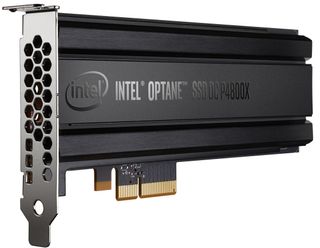Intel 3D XPoint Optane SSD DC P4800X Performance Preview
Final Analysis
Bringing a new memory to market is perhaps the most challenging of all semiconductor endeavors. There’s no doubt that Intel overcame the hurdles in its way to bring 3D XPoint to market, at least in a standard SSD form factor, but there is still a long road ahead for the fastest non-volatile media we’ve ever tested.

While the DC P4800X outstrips our expectations, the devil is in the details. The industry hasn’t had a successful new memory technology in ages, largely because it requires retooling much of the supporting infrastructure. Intel tells us that it brought together the NVMe Consortium with its then-secret memory in mind.
The next steps involve software, and we've already seen signs of a coming revolution. New commands are already built in to major operating systems, enabling a persistent memory ecosystem. Intel and Micron both have an impressive list of industry partners to help ensure the software side comes together smoothly. Intel also offers its value-add Memory Drive Technology, which merges the DC P4800X into the memory subsystem, making it look like a large pool of memory to the host. This enables tremendous potential for in-memory compute applications.
Now it's time to see if Intel can sell this thing. Price is a crucial concern of course, but it's only one of many considerations. NAND-based SSDs scale performance with capacity, so buying more of the latter gets you more of the former. Most applications don’t need the 2TB of storage found on leading-edge SSDs though, so the extra capacity is often underutilized.

Micron released a chart showing how well its 3D XPoint-powered QuantX SSDs scale without additional capacity. As you can see, larger variants offer nearly the same performance as smaller ones. The same likely holds true for Intel’s Optane drives as well. Data centers typically over-provision capacity in search of higher performance, but buying smaller Optane models will help offset at least a portion of the cost differential. The DC P4800X's IOPS-per-GB metrics are off the charts. We tested a relatively small 375GB model, but Intel has larger configurations in the pipeline in both AIC and U.2 form factors.
Power consumption also seems to fall within expectations. Intel indicates the DC P4800X sips 12-14W, and in tandem with the exceptional performance, we expect it to deliver industry-leading IOPS-per-watt. We conduct granular power testing (on SSDs that we can actually touch) and quantify performance-per-watt metrics in our lab. We have to reserve our judgement of efficiency until we have samples in-hand, but the specs appear impressive.
The endurance picture isn’t quite as robust as we hoped, but it’s not bleak. Of course, it's hard to draw conclusions about endurance when we don't have more details about the the error correction implementation. But Intel clearly specs the DC P4800X’s endurance metrics, which are adequate for their target applications, and covers it with a three-year warranty. Intel also bumps the three-year warranty to five years for larger models. The company is known to increase its endurance ratings after field reliability studies, and it plans to refine this product's endurance metrics in the future, too.
Stay on the Cutting Edge
Join the experts who read Tom's Hardware for the inside track on enthusiast PC tech news — and have for over 25 years. We'll send breaking news and in-depth reviews of CPUs, GPUs, AI, maker hardware and more straight to your inbox.
Although the DC P4800X is more expensive than NAND-based alternatives, it offsets the price with unmatched performance in nearly every workload. We evaluate storage devices to find both strengths and weaknesses, but it’s hard to find any area where the DC P4800X underperforms. It does have lower sequential read throughput under heavy load than other devices, but its great scaling under lighter loads and impressive QoS metrics outweigh the disparity for most applications.
IOPS, throughput, latency, QoS, standard deviation—it’s all there in spades. This is the best enterprise SSD I’ve tested (remotely or otherwise), and I’ve tested a great many. We can’t give an award at this stage due to the remote testing and preview nature of our story, which adds too many variables. After all, we insist on strict test methodology. But once Intel gets us final hardware (and a manual with specifications), we have a feeling the DC P4800X is a winner. The future of persistent memory is at hand, and Intel's DC P4800X shows that it's bright.
MORE: Best Enterprise SSDs

Paul Alcorn is the Managing Editor: News and Emerging Tech for Tom's Hardware US. He also writes news and reviews on CPUs, storage, and enterprise hardware.
-
Geekwad A true signal that raw processing power is played out.Reply
Storage of all kinds and an increased focus on parallelism in software implementations is more exciting. -
anbello262 I can't wait to have the consumer version. I can cleary see in a few years ssd replacing hdd for storage, and xpoint replacing ssd for OS/boot/programs.Reply -
shrapnel_indie Call me when the testing is completed with real hardware on hand. Its too easy to simulate in a virtual environment. (Not saying they did, but the potential exists.) The numbers are nice though.Reply
Most Popular


